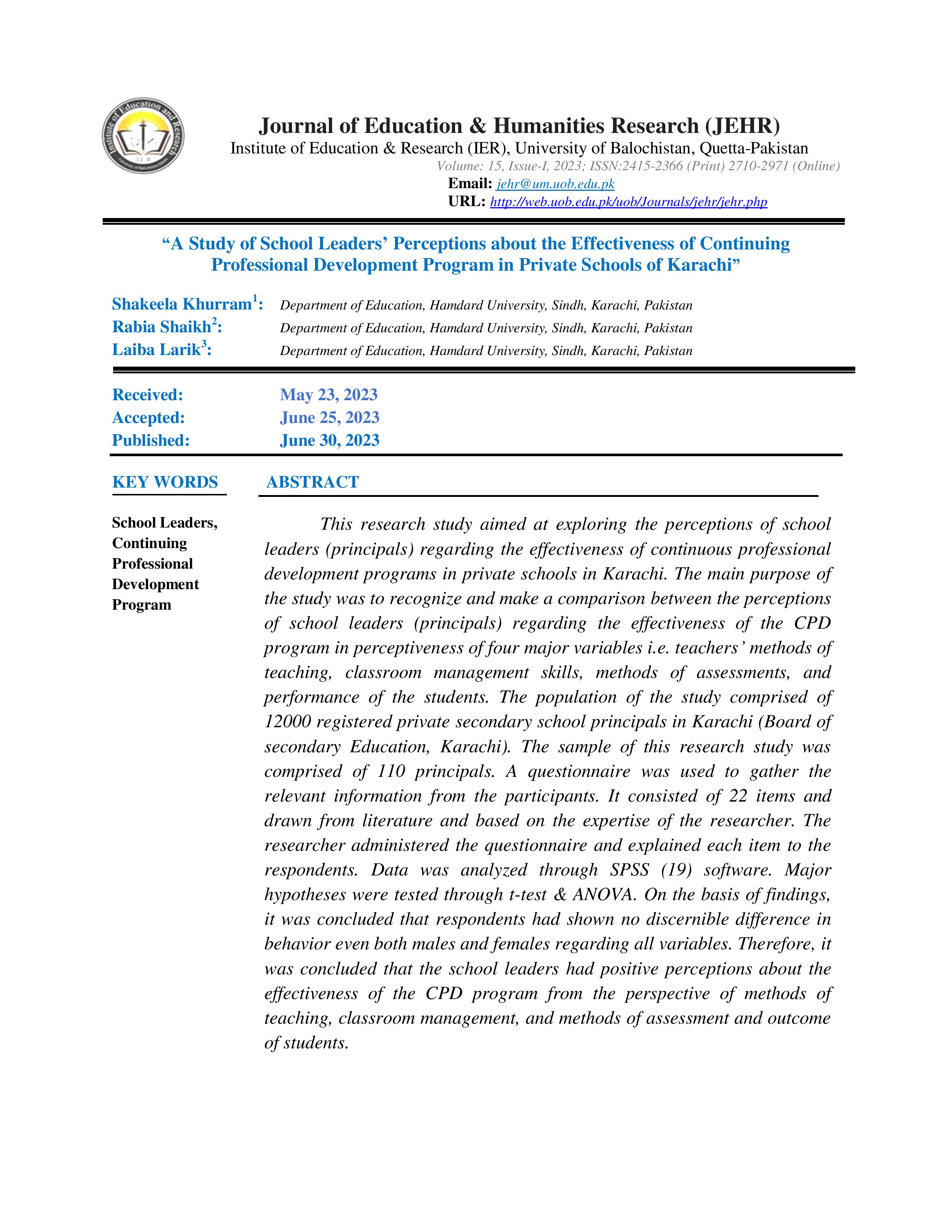A Study of School Leaders’ Perceptions about the Effectiveness of Continuing Professional Development Program in Private Schools of Karachi
Keywords:
School Leaders, Continuing Professional Development ProgramsAbstract
This research study aimed at exploring the perceptions of school leaders (principals) regarding the effectiveness of continuous professional development programs in private schools in Karachi. The main purpose of the study was to recognize and make a comparison between the perceptions of school leaders (principals) regarding the effectiveness of the CPD program in perceptiveness of four major variables i.e. teachers’ methods of teaching, classroom management skills, methods of assessments, and performance of the students. The population of the study comprised of 12000 registered private secondary school principals in Karachi (Board of secondary Education, Karachi). The sample of this research study was comprised of 110 principals. A questionnaire was used to gather the relevant information from the participants. It consisted of 22 items and drawn from literature and based on the expertise of the researcher. The researcher administered the questionnaire and explained each item to the respondents. Data was analyzed through SPSS (19) software. Major hypotheses were tested through t-test & ANOVA. On the basis of findings, it was concluded that respondents had shown no discernible difference in behavior even both males and females regarding all variables. Therefore, it was concluded that the school leaders had positive perceptions about the effectiveness of the CPD program from the perspective of methods of teaching, classroom management, and methods of assessment and outcome of students.
References
Akhtar, M. (2000). A Comparative Study of Formal & Non-Formal Training Programs of
Secondary School Teachers in Pakistan. (Unpublished)M. Phil. Thesis, University of Arid Agriculture, Rawalpindi, Pakistan.
Alausa, Y. (2014). Continuous assessment in our schools: Advantages and problems. Unpublished, Kolin Foundation Arandis, Namibia.
Ali, S. (2008). Faculty development program for universities of Pakistan: The need to develop a model, (Unpublished doctoral thesis). Lahore: University of Punjab.
Aslam, H. D. (2011). Analyzing professional development practices for teachers in public
Universities of Pakistan. Mediterranean Journal of Social Sciences, 2(4), 97-106.
Atay, Derin. (2008). Teacher Research for Professional Development. ELT J, 62 (2), 139-147. doi:10.1093/elt/ccl053.
Barrs, J. (2005). Factors Contributed by Community Organizations to the Motivation of Teachers in Rural Punjab, Pakistan, And Implications for the Quality of Teaching. International Journal of Educational Development, 25 (3), 333-348. doi: http://dx.doi.org/10.1016/j.ijedud ev.2004.11.023
Baylor, Amy L., & Ritchie, Donn. (2002). What Factors Facilitate Teacher Skill, Teacher Morale, and Perceived Student Learning in Technology-Using Classrooms? Computers & Education, 39(4), 395–414. http://dx.doi.org/10.1016/S0360- 1315 (02)00075-1.
Bell, C. R., & Goldsmith, M. (2013). Managers as mentors: building partnerships for learning. Barrett- Koehler Publishers.
Blank stein, A.M. (2004). Failure is not an option: six principles that guide student achievement in high-performing schools. Thousand Oaks, California: Corwin Press.
Borko, H. (2004). Professional development and teacher learning: Mapping the terrain. Educational Researcher, 33(8), 3- 15.
Boyle,B.,D.While, and T.Boyle.2004. A longitudinal study of teacher change: What make professional development effective? The Curriculum Journal 15, no.1:45– 68. Centre for the Use of Research and Evidencein Education (CUREE).2008.
Bredeson, P. V. (2000). The school principal’s role in teacher professional development. Journal of in-service education, 26(2), 385-401
Casalegno, L.P. (2000). Peer power. Principal Leadership (Middle School Ed.), 1(3), 42-5. Clarke, David, & Hilary Hollingsworth. (2007), “Elaborating a Model of Teacher Professional Growth.” Teaching and Teacher Education,18(8), 947–967.
Cobb, J.B. (Fall 2000). The impact of a professional development school on pre-service
Teacher preparation, in-service teachers’ professionalism, and children’s achievement: Perceptions of in-service teachers. Action in Teacher Education, 22(3), 64-76.
Cocklin, B., &Wilkinson, J. (2011). A case study of leadership transition: Continuity And change. Educational Management, Administration & Leadership 39(6): 661- 675.
Daft, R. L. (2005). The Leadership Experience. Canada: Thomson.
Dagnew, Kelkay& Asrat, (2018). School principals’ and supervisors’ leadership practices in teachers’ continuous professional development program: in the secondary school of Bahir Dar city, Ethiopia. International Journal of Leadership in Education, (), 1–13.
Derek Glover, S. Law. (1996). Managing professional development in education. ISBN 9780749419899, Published by Routledge, 196 Pages.
Desimone, L.M. (2011). A primer on effective professional development. Phi Delta Kappan, 92 (6), 68-71
Desimone, L.M. (2009). Improving impact studies of teachers’ professional development: Toward better conceptualizations and measures. Educational Researcher, 38(3), 181- 199.
DiPaola, M.,& Wagner, C.A.(2018). Improving instruction through supervision, evaluation, and professional development. Scottsdale: Information Age Publishing.
DSD. (2007a). Continuous professional development framework for primary school teachers. Directorate of staff development, Punjab. Lahore, Pakistan: Directorate of Staff Development, Government of Punjab.
DSD. (2013). Professional development for quality education: teachers’ guide, lesson plans. Directorate of Staff Development, Government of Punjab.
Edmonton, AB: Author, (2001). Enhancing Teaching Practice for Student Learning: A Framework for Professional Development.
Erickson, Brandes, & Gabriella, M. (2005). Collaborative Teacher Learning: Findings from two Professional Development Projects. Teaching and Teacher Education, 21, (7), 787- 798.http://dx.doi.org/10.1016/j.ta te.2005.05.018.




